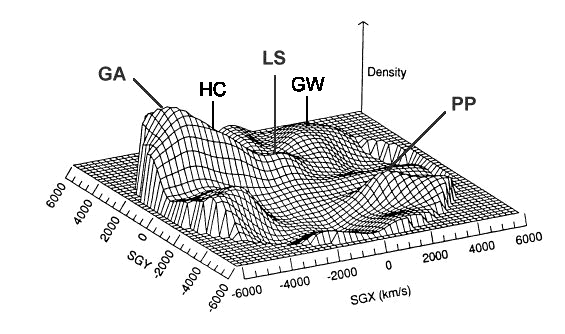Large Scale Structure
How does it all fit together (at least for our local neighborhood, the region observable in amateur telescopes)?

Mass Density for the Region within about 300 Million Light Years

Mass Density for the Region within about 300 Million Light Years
Most prominent is the Great Attractor [GA], a mountain of dark matter including and rising up beyond the Hydra - Centaurus cluster [HC]. The Local Supercluster [LS] also shows as a ridge of higher-than-average mass density that runs toward and merges with the Great Attractor. On the other side of the sky rises another mountain of dark matter, somewhat steeper but much less broad--this matches up with the position of the Perseus-Pisces Supercluster [PP]. In between the two mountains is a valley, an elongated void of lower-than-average density.
These four pieces of terrain--the Great Attractor and the Local Supercluster on one side, the Perseus-Pisces Supercluster on the other, and the void in between--are the major features of both the dark matter map inferred from the motions of galaxies (their peculiar velocities) and the IRAS map of the positions of galaxies. These maps, though coarse, suggest a good correspondence between the galaxy and dark matter distribution, at least on large scales like superclusters.--Alan Dressler
(Another prominent feature of our observable universe, the Great Wall [GW] of galaxies discovered by Margaret Geller and John Huchra, lies just outside our map, but we can see its outer ramparts in the low ridge running across the top.)
The Great Attractor may be just the tip of the iceberg. This entire region may be streaming at 600 km/sec, a ripple in the smooth Hubble flow of an expanding universe, toward a truly gigantic conglomeration of mass, known as the Shapley concentration, in the same direction as the Great Attractor, but almost three times further away.
